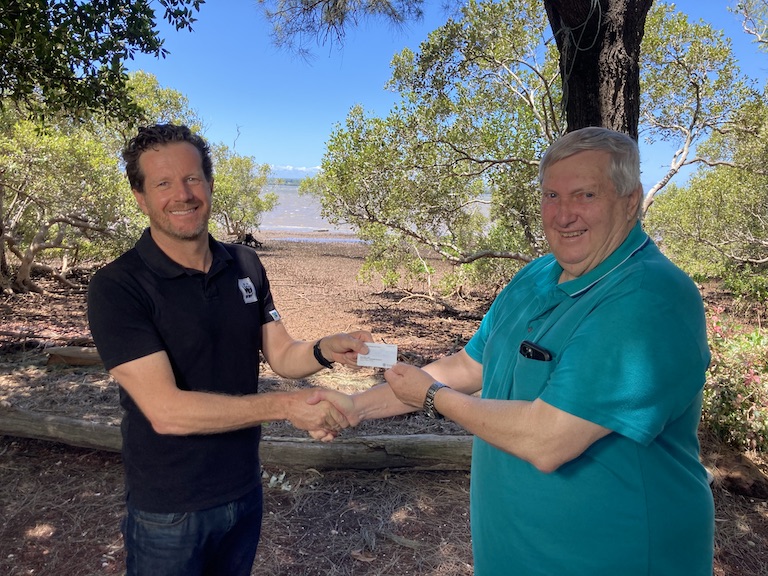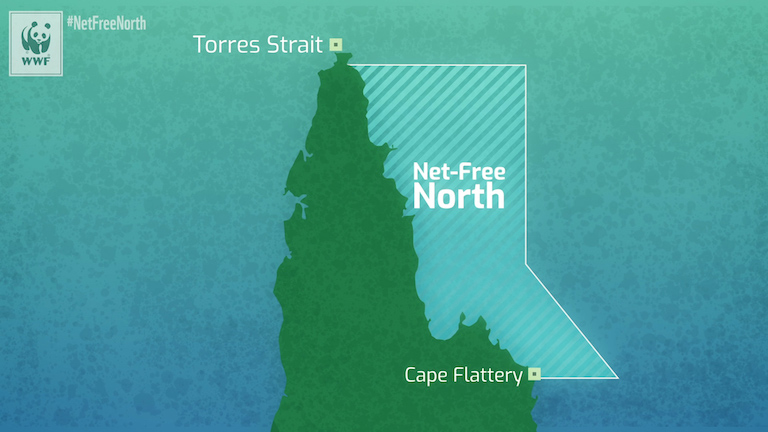
- In an effort to protect dugongs and other threatened species, WWF-Australia bought a commercial gillnet fishing license for a swath of ocean in the northern Great Barrier Reef, to establish a de-facto marine sanctuary spanning more than 100,000 km2 (38,600 mi2).
- Dugongs, turtles, dolphins and other marine animals are easily caught in gillnets, and experts say many fatalities go unreported.
- The newly protected region is an important feeding ground for dugongs, supporting a local population of about 7,000, experts say.
- WWF-Australia says it hopes the Australian and Queensland state governments will establish more permanent protections for dugongs on the Great Barrier Reef, and that Traditional Owners can use the area for sustainable fishing and tourism.
In 2017, a dugong washed ashore on a beach north of Townsville, Queensland, near the Great Barrier Reef. The dead animal had scratch marks on its belly and back, and there were also cuts around its fluked tail. Experts said the dugong, which is a protected species in Australia, had probably gotten caught in a commercial fishing net.
This certainly isn’t the only dugong (Dugong dugon) to die in the clutches of a net. While fishers have only reported 12 dugong deaths during commercial operations between 2006 and 2012, reports from independent observers suggest that an estimated 422 actually died during this period, the conservation group WWF-Australia said. Overall, fishers are “massively underreporting” the deaths of protected species like dugongs, as well as dolphins and turtles, the NGO said.
To help protect marine wildlife in the Great Barrier Reef region, WWF-Australia did something unconventional: it bought and shelved a commercial gillnet license to create a 100,000-square-kilometer (38,600-square-mile) refuge that sprawls between Cape Flattery and the Torres Strait.
“We put a call out to our supporters and donors and said, ‘Would you be interested in directly being involved in conservation in this region?’” Richard Leck, the head of oceans and sustainable development at WWF-Australia, told Mongabay in a phone interview. “The overwhelming response was ‘yes.’”

Prior to the sale, the license had been owned by commercial fisher Tony Riesenweber, who said he’d planned to refit his boat and use gillnets to fish for shark, barramundi (Lates calcarifer), and fingermark bream (Lutjanus russellii) this year.
“Had WWF not approached me, it would have been fishing by the opening of [barramundi] season which is now,” Riesenweber said in a statement.
Leck said that buying the license involved a “long negotiation” process, but that Riesenweber ended up being “very supportive.”
“He is keen to see this area be established as a permanent net-free zone,” Leck said. “I think, in general, many fishers realize that they do impact on threatened species, particularly in areas where there are higher concentrations of threatened species … and certainly this area of the Great Barrier Reef — this northern area — is one of those locations.”
Leck added that this was the “last major commercial gillnet license” for this region, and that WWF-Australia now owns about 90-95% of the available gillnet fishing quota for the area. The NGO also owns four other commercial fishing licenses along the Great Barrier Reef, including two offshore gillnet licenses bought in 2016 to ease fishing pressure on different species of hammerhead sharks, which tend to get captured as bycatch.
“It’s not WWF’s desire to hold commercial licenses forever and a day,” Leck said. “There are fees that we have to pay that’s associated with that. Ultimately, we would like to surrender these licenses, but we would only do that when there is a system of permanent protection in place for this region, and that permanent protection needs to come through leadership from the Australian and Queensland governments.”
WWF-Australia said the sale amount was in the “low six figures in Australian dollars,” but that the exact number isn’t being publicized at the request of the seller. There are also annual fees, including A$1,950 ($1,470) for the license itself and A$700 ($525) for the quota, WWF-Australia said.
The buying of this latest license is part of a campaign called Net-Free North, which aims to establish the largest marine animal sanctuary in the northern section of the Great Barrier Reef.

“By taking the action we’ve taken, we’ve effectively created a refuge for turtles, dugongs and inshore dolphins, because that area is largely unavailable to be fished from other commercial operators,” Leck said.
The newly protected area in the northern part of the Great Barrier Reef is an important feeding ground for dugongs, as well as turtles and dolphins, said Helene Marsh, a dugong expert at James Cook University in Queensland. She added that the seagrasses in this region that form the dugongs’ diet do not appear to be currently threatened by climate change or other pressures.
“Australia is the dugong capital of the world and the populations are mostly in good condition,” Marsh told Mongabay in an email. “The situation in many of the 40 or so range states outside Australia is dire.”
The IUCN, an authority in the conservation status of species, classifies dugongs as vulnerable to extinction, with key threats being entanglement in fishing nets, hunting, boat strikes, and the degradation and loss of habitat and food sources.
Marsh called WWF-Australia’s initiative a “significant step forward.” She added that while gillnet fishing is banned in most other dugong habitats along the Great Barrier Reef, animals can “move between closed areas and can be exposed to nets.”
There are up to 323 gillnets being used on an annual basis in other parts of the Great Barrier Reef region, according to WWF-Australia. Many of these are large mesh nets, ranging from 600 to 1,200 meters (nearly 2,000-4,000 feet) in length, while others are smaller “bait nets” used in crab pots, the NGO said.
Marsh said that dugongs get easily caught in gillnets since they feed on seagrass on the ocean floor.

“They encounter nets while feeding in murky water and then tend to roll and get tangled,” she said. “This is the major cause of dugong mortality worldwide.”
Many species of turtles, dolphins, sharks and rays such as sawfish are also vulnerable to gillnets. In 2019, WWF-Australia released an image of protected hammerhead sharks “stacked up to waist height,” on the deck of a fishing boat to illustrate the destructive nature of gillnets.
WWF-Australia said that there is ongoing dialogue with the Queensland and Australian governments about putting measures into place to protect dugongs and other species on the Great Barrier Reef, but that there hasn’t yet been the “breakthrough” the NGO is hoping for.
Mongabay reached out to the Great Barrier Reef Marine Park Authority (GBRMPA), the government agency responsible for managing the park, but did not receive a response by the time this article was published.
Leck said that while the license will never be used for commercial gillnetting again, WWF-Australia is exploring the possibility to work with the region’s Traditional Owners, as Indigenous peoples in Australia are known, to give them the opportunity to sustainably fish in the region, or to establish small charter fishing and tourist operations in the area.
“If we get to that ultimate destination of the government also stepping up to protect this area, and being able to pass the licenses to Traditional Owners for them to help manage their sea country, then I think we’ve got an outcome that is great for the reef, good for the fisher, and really great for those local communities,” Leck said.

Banner image caption: A dugong swimming in the sea. Image © Istockphoto.com / WWF.
Elizabeth Claire Alberts is a staff writer for Mongabay. Follow her on Twitter @ECAlberts.
FEEDBACK: Use this form to send a message to the author of this post. If you want to post a public comment, you can do that at the bottom of the page.
WWF casts a wide net to save dugongs in the Great Barrier Reef
Source: Trends News

0 Comments